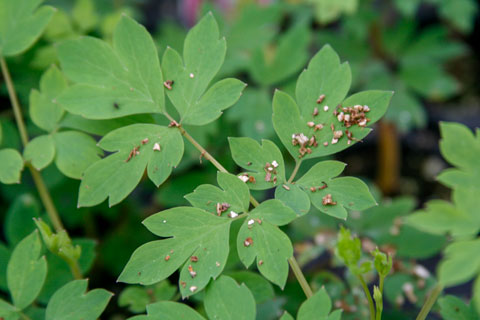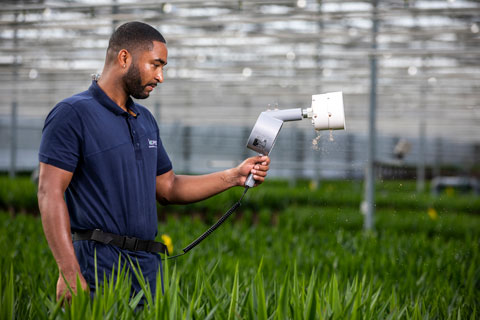4/1/2024
IPM: A Retail Perspective
Lowell Halvorson

Biologicals have entered the mainstream as a viable alternative to pesticides among wholesale plant producers. Can retailers benefit from the same trends when planning their integrated pest management (IPM) systems? The answer is a qualified yes, depending on the size of the problem.
Pictured: Amblyseius swirskii applied over the top of a crop
of dicentra. This predatory mite has no eyes, so even distribution is crucial for predictable control of problems like mites, thrips and whiteflies. They can’t see the plant next door, so the goal is to evenly apply the mites over the plants.
A quick check is the frequency of spraying. If you don’t need to hit your plants often, just keep doing what you’re doing. However, if you need to develop a scheduled spraying routine, then biologicals gain traction. IPM is best as a long-haul solution when you need to get down to the root.
Another quick check is the presence of in-house growing. Problems develop when plants stick around for a while. Due to their high product turnover, retail benches rarely have time to develop pest issues. This isn’t true for crops grown in-house. Pests settle in when plants stay put as they grow. An added complication: sometimes those growing spaces are open to the public as well.
A third check is the house style of solving problems. Chemical pesticides work like fixing cavities: After the repair, you’re done until the problem reappears. With biosolutions, you brush your teeth to prevent the problem, but a good habit intermittently applied doesn’t achieve the goal.
Now, the presence of chemistry in your operation doesn’t mean you can’t approach living solutions as well. There’s a lot of gray area when it comes to IPM. Pest control swings from a spectrum of hard chemistries through soft ones, fungal spores, good bacteria and beneficial nematodes on up to various predatory insects. The choices are broad and their ability to integrate lives within all the little details. Someone has to steer through these shoals.
The Job of the I

n-House Champion
Money doesn’t determine success with IPM projects. That lever is pulled squarely by staff and management. Here’s the twist: Building an IPM plan requires a mindset that likes to plan ahead in order to prevent problems rather than reacting with knee-jerk solutions. To keep the IPM program running over the long term involves a crew that wants it. Half-committed is half-dead.
Pictured: Staff can achieve larger coverage areas with hand-held blowers designed for the task. The Mini-Airbug applies the predatory mite Amblyseius swirskii to a crop of yucca seedlings.
Designating an in-house champion gives the project internal focus and breathing room. Remember, IPM is a muddy gray area of possibilities. That mud is slung against a business with moving parts and shifting priorities that collide for attention and resources. For an IPM program to stick, it has to navigate those rough decisions and the in-house champion pilots the ship.
We aren’t talking about the big picture decisions, but the thousand-and-one irritating little issues that aren’t even seen until they land on top of the pile. An internal champion should know the business as well as the pests so they can make the right decisions quickly.
The Role of the Outside Expert
You’d think the roles of the outside expert and the in-house champion would overlap, but they rarely do. Instead, they intersect. While the in-house champion chases down on-property issues, the outside expert collects off-property data, roaming through factories, supply houses and other garden centers to assess solutions. Insiders go places outsiders can’t and vice versa. When solutions are highly tailored to specific situations and locations, it’s this intersection of knowledge that works in the long term.
Plant brokers have offered outside expertise for decades so it’s not a strange concept for the industry. Outside experts become well-informed by asking other companies (such as your competitors) about their IPM programs, the problems they faced and the solutions that worked.
Both the in-house champion and the outside expert assess application strategies, quiz the suppliers on their products, factor in regional climate and neighborhood terrain, and collect judgements about the reliability and efficacy of any given solution. If an in-house champion looks at the IPM problem vertically, the outside expert examines it horizontally. You get two critically different viewpoints on the same problem.
Starting Gradually
Because IPM is such a gray spectrum, starting gradually is the way to get things done. Starting small, then adding a little more, is an incremental strategy more likely to succeed. You can understand problems more easily, learn from successes earlier and adjust spending more quickly. It’s easy to get entangled in the biodiversity of IPM, but three things stand out: the cost of the program, the benefit to the products and staff, and the ability to keep a solution running. Simplicity is your friend here.
A good example is the Dramm AutoFogger paired with a weekly application of a mycoinsecticide. Two reasons are often quoted: first, a fungal insecticide has low restricted entry interval (REI) burdens. Second, pests don’t develop a resistance to it. In addition, it requires a low labor commitment, mimicking a preventative pest treatment easy for one person to maintain weekly. Most retail firms are torn between two extremes, with more money than workers in May and more workers than money in months not named May. I exaggerate, but the brutal impact of labor load determines the fate of many programs.
Look for simple solutions for simple-ish problems. If a problem is too complex, break it into a chain of smaller problems that need smaller solutions and solve those over time.

The Heart on the Sleeve
I should mention the marketing value of a decent IPM program. Claim credit with your direct customers. Business values influence customer buying decisions just as much as price. A certain segment of the market would swing their dollars in your direction if they only knew.
Pictured: Modern IPM programs favor surgical strikes to remove problem spots before they become pervasive. Experts assess the significance of evidence gathered from a variety of traps, then tailor solutions to meet that need.
Explain the IPM program as an extension of your business values. “We Run a Living Business” is a headline that says it all. A simple placard with a small announcement underneath, placed by the cash register, is not a big effort and not expensive, but meaningful. Who are you and what do you believe in? IPM expresses those values in a concrete way that impacts your customers directly, so don’t hide it. Be proud, be distinctive and think differently.
A more playful approach is a tagline like “New Sheriff in Town” with wanted posters for the bad bugs and “Meet the Deputy” posters for the good bugs. They’re conversation starters or talking points that engage the community with your staff. IPM isn’t just wonky work for the bug nerds; it’s more effective with a whole team approach. It’s different, it makes you unique and it resonates with customers. GP
Lowell Halvorson is a consultant and writer in Fairfield, Connecticut, for retail and wholesale horticulture, specializing in business development. He also covers the breeding community for GrowerTalks magazine. You can contact him at (203) 257-9345 or halvorson@triadicon.com.